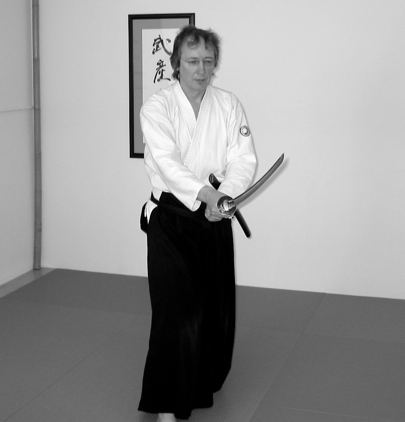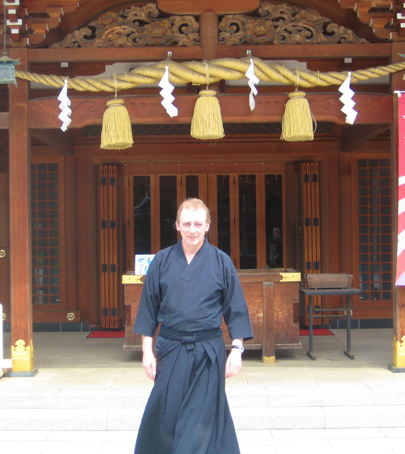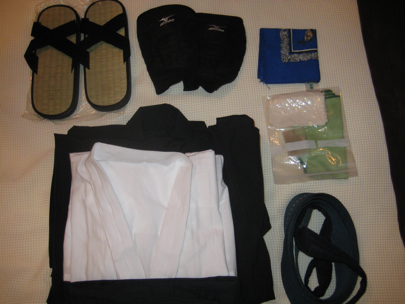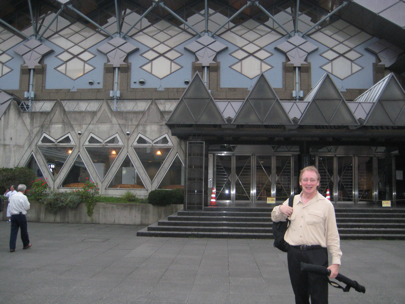 |
| In the mouth of the dragon, Showa Kinen park, Tachikawa City, Tokyo |
Oh my, it's nearly the end of the year and I really should put up a couple of posts before we enter a new decade (or is that next year?). Anyway, I've mentioned on a few occasions that I practice martial arts. I don't talk about it a lot as the techniques are arcane and meaningless to most people and somehow it seems undignified to bang on about and my expertise (or lack, thereof)*. However in 2009 I achieved a significant milestone in my practice. This is the last of my summer adventures in the "What we Did on our Holidays" series: here's the story.
My training in martial arts started when I was an undergraduate. Since that time I've followed "the path" in a somewhat discontinuous and haphazard manner and as a result am a great example of underachievement in terms of rank and physical skill. Nevertheless I have persisted over the years and more recently have been training in the art of iaido or sword drawing. Just over 12 months ago my Sensei (teacher) suggested that it would be appropriate for me to take the shodan (1st degree black belt) examination and that I should plan my preparations accordingly. The test would be held in Tokyo in September (of 2009) and I was quite elated by the prospect, so at the beginning of the year I began training in earnest.
 |
| In training, c2007 |
While I thought I was capable of making the shodan grade, the reality was that I had something of a mountain to climb: every aspect of my technique needed extensive polishing as did my mental conditioning. Furthermore my equipment needed fettling and my uniform was sub-standard. Iaido puts an emphasis on quiet grace, confidence and absolute correctness of form. Thus sub-optimal appearance, posture and deportment is judged negatively. And so around the beginning of 2009 I began a programme for systematic improvement of all these facets of the art.
At first glance the grading requirements appear quite straight forward. Perform five out of a set of twelve standardised kata or forms as directed by the All Japan Kendo Federation (ZNKR) within six minutes. But this to be done with precision and style in front of a panel of four hachidan (8th dan masters -supremely accomplished individuals) at the mecca of martial arts, the Tokyo Ayase Budokan hall. Very cool: but what sounded like a straightforward task at the beginning of the year became an increasingly intimidating prospect as the test approached.
I increased my formal training to three times a week -this included at least one session of intense personal instruction from my Sensei. I took copious, detailed, notes (something very new to me, even after years of training) and even tried practicing with a metronome to get the correct rhythym and timing (for those who are interested in the technicalities of all this, 66 beats per minutes is about right).
As Spring approached, I realised that I needed to improve my physical conditioning. I thus embarked on a supplementary gym regimen that involved cardio training, weights, yoga, balance exercises, core routines etc. My trainer was Michael Schauble, who was not only an outstanding football and track athelete in his college days but also Washington State taekwondo champion. With his martial arts background, Michael very quickly picked up on what I was trying to achieve and designed a custom set of exercises for me.
So with physical training of some type going on every day, I continued other preparation at home. I reviewed videos of the techniques, purchased a new de luxe uniform with a nice secure obi (belt) and organized my equipment. My Sensei lightened my sword by more that 100 grammes (no sense getting a repetitive strain injury -I spent half of 2008 in acupuncture for tendonitis) by swapping my lovely wrought iron tsuba (hand guard) for a plain but much lighter aluminium item. I carefully added some decorative patination with a Dremel tool and finally treated the sword to a new silk sageo (retaining cord) that matched my obi.
 |
| This lovely tsuba was replaced with a more prosaic but much lighter and more functional item |
 |
| At the Tachikawa Shrine, September 2009 |
The morning of the test arrived. I got up early, took a long hot bath, arranged my equipment and lightly oiled my sword. I didn't want to feel rushed or harried. In iaido composure is everything and I tried hard to be internally quiet. It also happened to be my birthday which I felt was auspicious and this gave me confidence.
 |
| Fresh uniform and equipment carefully laid out and checked on the morning of the examination |
Our group made its way across Tokyo (the public transport system must be the most efficient and orderly in the world) and arrived with time to spare at the Budokan Hall. The doors were not to open until 9.00am and by the time we were allowed into the building there must have been several hundred iaidoka waiting outside. I've never seen so many swordsmen (and women) in my life. I duly registered at the front desk and presented my essays (formal writing on theoretical aspects of iaido is part of the test) and found a place to get dressed. With around 500 students testing at various levels, nobody bothered with the changing rooms and space was at a premium. I pulled on my uniform: Sensei was there to ensure our sartorial elegance. While shodan ranking semed like a lofty goal, it's the most lowly of the yudansha (black belt) ranks and the examiners conduct these tests first. My number was called quite quickly: I bowed to my group of fellow examinees and lined up on the edge of the arena. At the command of "Hajime!" (begin) I started my kata. I began a little anxiously and then muscle memory took over. This was certainly no time to be thinking through techniques. Then it was all a blur. Even immediately after the test I could remember very little about it other than (i) I'd slightly over oiled the blade of my sword and I was very conscious that I had to be careful not to lose contact with my left hand on the noto or re-sheathing movements (ii) my super new hakama (voluminous pants worn by certain martial artists) was about 1" too long and I should avoid tripping over it at all costs and (iii) the candidate in front of me was performing way too quickly and I felt very confident that I could complete the test safely in about five-and-a-half minutes of the six minutes allowed (if this time is exceeded, the candidate will fail: no clock is visible and practitioners must use their internal timing to gauge the duration of their performance). And then, after almost a year of training, it was all over. It retrospect it seemed like the blink of an eye. There was nothing to do but hang around and wait for the results to be posted.
Fortunately we weren't kept in suspense too long. The results were tacked up as each rank block was completed. I had passed along with most of the shodan candidates although it is worth noting that the failure rate became quite severe around sandan (3rd degree black belt). I was now a black belt in a traditional Japanese martial art. I'd finally accomplished an important objective and was elated. Now it was time to celebrate before facing the long trip back to Seattle.
 |
| Outside the amazing Ayase Budokan hall, happy in the knowledge that he is now part of The Dark Side |
Post Script. So now, nearly four months after this test, it's important to retain a sense of perspective. Attaining the rank of 1st degree black belt does not make me any kind of expert. It's simply a demonstration of basic competence in the art. Many practitioners refer to it as an "official beginner" -the point at which real training and understanding starts. But more than this, rank is just an artifical system of categorizing students. The objective of training in a martial art is training per se and not material achievement. Nevertheless it's nice to have got to this point and at least I know that I will never again have to change my belt colour. Finally, I must acknowledge all the efforts of my martial arts teachers, particularly those who have instructed me in sword techniques. These include Sensei T.K. Chiba, Dee Chen, Len Bean, Aniceto Seto, Tatsuhiko Konno, Pat Murosako and notably Jonathan Bannister, Kaicho of Tsubomi Dojo, Seattle, who spent a year preparing me for this extraordinary trip to Japan. I must pay tribute to the memory of Kenshiro Abbe Sensei: I saw him give a demonstration of iaido in the UK, c1971, and I've been fascinated by Japanese sword arts ever since. Domo arigato gozaimashita!
*As I write, I'm thinking that some of my stories from this long journey are worth few column inches of blog so if you are interested, watch this space.
No comments:
Post a Comment